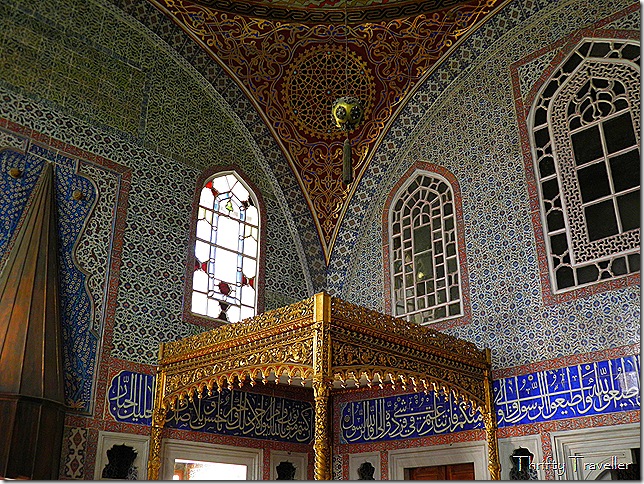The Topkapi Palace Museum Harem Apartments are among the top tourist attractions at Topkapi Palace.
For almost 400 years (1465-1856), Topkapi was used as the primary residence for the Ottoman Sultans and the harem was where the Sultan and his family lived and had their private apartments.
Entry beyond the gate to the harem was prohibited except to the Sultan, the queen mother, the Sultan’s consorts,concubines and favourites, the princes and the eunuchs guarding the harem.
Now, for 15 Turkish Lira, tourists can take a peek inside. It is a labyrinth of passageways, courtyards, ornate rooms, canopied seating areas, finely decorated tiles, exquisite calligraphy and exotic lattice screens from behind which women could see what was going on unobserved.
The Privy Chamber of Sultan Murad III, built in 1578, is particularly sumptuous with its gilded canopy and walls lined with the finest Ottoman tile art.
While the architecture is lovely, I feel it would have been nice for the museum to provide a little more information about what life was like in the harem and display paintings and photos of some of the people who lived there. Or maybe even employ a few actors and actresses to lounge around on their ottomans (excuse the pun), idly fanning themselves with peacock feather while their bodyguards look on. But I suppose you just can’t find the eunuchs these days!
In the absence of this information I have had to conduct a little of my own research:
Orientalist Artists’ Images of Harems
Most people’s impressions of an Ottoman harem would have been influenced by Hollywood or by fanciful paintings by Orientalist artists like John Frederick Lewis or Jean Jules Antoine Lecomte du Nouy, who probably never stepped foot in a harem, or certainly never when semi-clad women were present.
The reality may have been somewhat different. In Philip Mansel’s fascinating book, Sultans in Splendour, he explains that in the Ottoman harem, women were divided into kadines (consorts), iqbals (favourites) and guezdes (those ‘noticed’ for a moment).
It is not known which category this lady of the harem fell into. (Perhaps she was employed by the Sultan’s mother for her skills as a backgammon opponent).
When this photo was taken in 1867, the Sultan had already relocated from Topkapi to the sprawling European style Dolmabahçe Palace.
By the year 1900 it was estimated there were still some 400-500 female slaves in the royal courts at Dolmabahçe, Yildiz and other residences.
Circassian Women
The majority of the female inmates in the harem were from Circassia, an area whose women were prized by the Ottoman Sultans for their beauty, elegance and spirit.
Where is, or was, Circassia? As this historical map shows, it was in the troubled north Caucasus region neighbouring Russian republics like Abkhazia, Chechnya, Dagestan and Ossetia which are often in the news for the wrong reasons.
Circassia (part of which is now renamed Krasnodar Krai) will certainly be in the news next year as its major city, Sochi, is hosting the 2014 Winter Olympics.
Eunuchs
In 1903 there were 194 serving or retired eunuchs at the Ottoman Court.
Typically they were seized in Sudan and castrated before sale. They were often sent to the Sultan as gifts by provincial governors in the Ottoman empire such as the Sherif of Mecca.
The Chief Eunuch managed the administration of the harem and as such was a powerful official.
Valide Sultan
The mother of the reigning Sultan (often a Circassian herself) was known as the Valide Sultan and was the most important woman in the empire. It was she who got to chose which harem girls to present to the Sultan thus giving her plenty of power.
Having a couple of hundred concubines to call upon might sound like a dream come true for most men but for the Sultan, it must have been somewhat spoilt by having his Mum in charge.
There is a three-tiered fountain in the Sultan’s privy chambers which may have been installed so that the sound of running water would prevent his mother from eavesdropping from behind lattice screens as he whispered sweet nothings into the ear of his iqbal.
Being a Sultan was not all it was cracked up to be!
Still, if he tired of his concubines, he could always turn to his dwarves for entertainment. They were retained at the Ottoman court to crack jokes and serve at table right up until the fall of the empire.
















